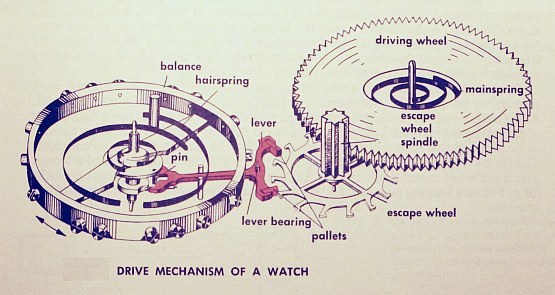previous <<==>> next
"TICK - TACK ... " WHY & HOW

A) H O W T H E D R I V I N G O F A W A T C H W O R K S
===================================================================
Picture taken from the book "The Way Things Work"
Simon and Schuster, NewYork (1967), p.215, Fig.3
-------------------------------------------------------------------
The "driving force" of the watch is the MAINSPRING ( with its gears
not shown in detail here !) to move the hands as we know it - BUT:
There must be "periodic stops" in between, otherwise hands would
run in full speed ... until the tension of the spring is exhausted.
Stopping is done with a circular pendulum (= BALANCE + HAIRSPRING )
moving a PIN back and forth. The PIN moves a LEVER back and forth.
On the end of the LEVER are PALLETS, gripping in the ESCAPE WHEEL's
teeth to "periodic stops". This makes the "TICK-TACK-TICK-TACK ..."
The shape of the two PALLETS and the shape of the ESCAPE WHEEL's
teeth has to be tuned so, that the BALANCE get a "push at the right
time" on its PIN to continue swinging.
This principle is also valid for bigger CLOCKS (e.g. SETH-THOMAS ).
B) HOW THIS PRINCIPLE APPLIES TO A P E N D U L U M CLOCK ...
===================================================================
Instead a "Circular Pendulum", a LINEAR PENDULUM does the same job:
Its PIN moves the LEVER with its PALLET-PAIR ...
LEARN MORE: Look at the REPAIR OF A SESSIONS MANTEL CLOCK ...
... and the "Driving Force" may be A WEIGHT ON A CHAIN ...
(e.g. HERMLE "OPEN IRON HOUSE" WALL CLOCK ).
impressum:
*******************************************************************
© C.HAMANN http://public.BHT-Berlin.de/hamann 11/12/18
|